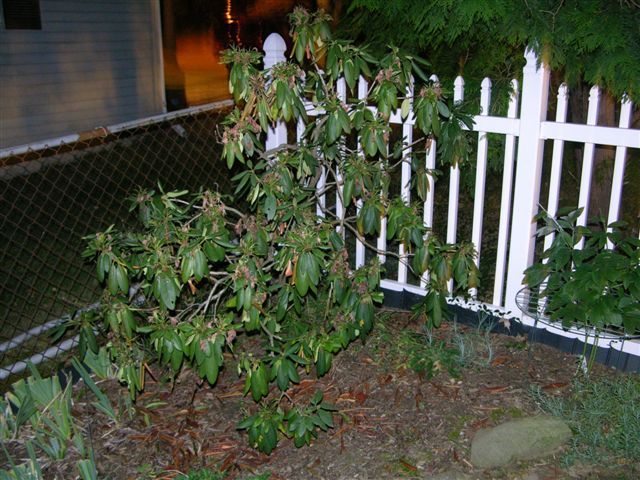Question Rhododendron
Rhododendron
QUESTION: I have a nice-size rhododendron that I transplanted in the fall 2 years ago from an area under some trees to a new garder where it is actually the centerpiece. It overwintered fine and bloomed the next spring as well as this spring (2008). However, I noticed that the flowers didn't seem to be losing their petals but rather they just dried in place on the plant. That seemed odd but I couldn't remember what they did in previous years so I didn't address it then. Now, however, the whole plant looks droopy. The dried flowers are still there although the leaves on the plant are still green, not perky and shiny though. There are also a lot of brown dead leaves on the ground under the plant. I'm attaching a couple of pictures. I really hope there is something I can do for this plant so it isn't lost!
ANSWER: Hi Judie,
Thanx for your question. Check the soil. If should be moist but not soggy. Rhododendrons don't like soggy soil but they don't like it bone-dry either and that will stress out the plant. From the picture, it looks like the soil might be quite dry. Water it once a week if you're not getting regular rain and give it a good soaking. Secondly, make sure it gets an acidic type of fertilizer there is food manufactured specifically for rhododendrons and azaleas available at your nursery or DIY. Nematodes can cause leaf drop and by attacking the roots can cause the blooms to die before opening up. If the soil in fact is too wet, root rot will cause leaf drop and blossoms to die. I hope this helps. Let me know if you need anything else.
Tom
---------- FOLLOW-UP ----------
QUESTION: Tom,
Thanks for responding about my poor rhododendron. I actually have an in-ground sprinkler system that is timed to go off every other night. I just checked the soil and, just under the thin layer of mulch, it is just damp. The sprinklers watered during the night last night. Since the garden is on a bit of a slope (you can't tell that in the picture), I would think soggy soil wouldn't really be an issue so hopefully I'm at least right about that. In the spring, I actually sprinkled some plant food (Vigoro - Azalea, Camellia and Rhododendron) on the ground under the bush, away from the stem/trunk but within the spread of the branches, per the instructions on the package. That leaves nematodes, but the blooms opened up beautifully and the leaves are mostly still attached. Are these the only possibilities?
AnswerHi Judie,
Thanx for the additional information. The only other possibility for me is this information I gleaned from Clemson University:
RHODODENDRON BORER
The rhododendron borer (Synanthedon rhododendri) is mainly a pest of rhododendrons but does attack azaleas. The borer is the immature form (caterpillar) of the rhododendron borer moth. The adult is a clearwing moth that somewhat resembles a wasp. The adult female lays eggs on the bark of the plant. The borer is pale yellow with a dark head and about ?inch long. It chews a hole to the inner bark and forms long tunnels in the branches. By late fall, it enters the sapwood where it survives the winter.
The rhododendron borer prefers twigs and small branches, but may infest main stems and branches as well. Leaves on infested branches are often off-color and wilted. Early symptoms are similar to those resulting from drought stress. In addition, infested branches tend to be somewhat stunted compared to healthy branches. Heavily infested branches turn brown and die. Damage from this pest is most evident in the fall.
To detect this borer, prune wilted branches and cut them open to see if the borers are present. There are also pheromone (insect chemical attractants) traps that are available. These traps attract only the adult males. The presence of male adults indicates the need for control measures to be taken.
Control: Nonchemical control is limited to pruning and destroying wilted branches. Chemical control with permethrin is directed at the adults. Treatment should take place in May and June. Thoroughly spray bark and repeat three times at 10 to 14 day intervals. Permethrin is available in products such as Bonide Borer/Miner Killer; Ferti-Loam Kill-A-Bug II; Spectracide Eight, Vegetable Fruit & Flower Concentrate; and Ferti-Loam Indoor/ Outdoor Insect Spray. As with all pesticides, read and follow all label instructions and precautions.
Another resource you might try is :
http://www.rhododendron.org/
I'm sorry I couldn't give you a better answer.
Tom






